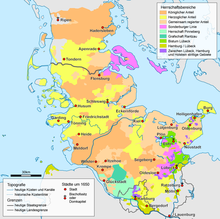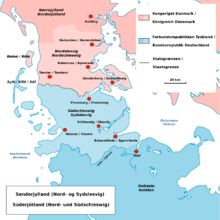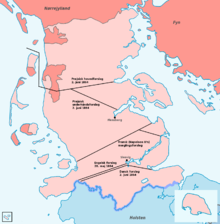South Schleswig
Südschleswig ( Danish : Sydslesvig ) refers to what is now the German part of the former Duchy of Schleswig .
As the northernmost landscape in Germany , the region extends from the Eider and the eastern part of the Kiel Canal in the south to the German-Danish border in the north. The term Südschleswig is mainly used by the Danish minority or in the historical context of the Duchy of Schleswig , which is now divided into South and North Schleswig by the German-Danish border . Otherwise one usually speaks of Schleswig or the part of Schleswig within Schleswig-Holstein . It covers an area of around 5300 km².
North and South Schleswig together make up about the southern third of Jutland .
geography

The Schleswig region stretches from the lower and middle reaches of the Eider and Kiel Bay to the Flensburg Fjord . South Schleswig or the part of Schleswig is not an administrative unit, but consists of the districts of Schleswig-Flensburg and North Friesland , the independent city of Flensburg and the northern part of the Rendsburg-Eckernförde district .
The affiliation of the city of Rendsburg , which was originally on an island of the Eider and today spreads on both banks, to Schleswig or Holstein has been disputed since the 13th century.
On the Baltic coast are the fertile landscapes of fishing (between Flensburg Fjord and Schlei ), Schwansen (between Schlei and Eckernförde Bay ) and Dänischer Wohld (between Eckernförde Bay and Kieler Förde).
The historical landscape of the Frisians, which was a little smaller than today's North Frisia district , includes the Eiderstedt peninsula on the west coast , the North Frisian islands (formerly Uthlande ) Sylt , Föhr , Amrum , Pellworm and Nordstrand as well as smaller Halligen and the coastal landscape behind them. The more sparsely populated Schleswigsche Geest inland does not represent an exactly delimited area. In the south lies the Stapelholm landscape between the rivers Eider and Treene , further east the Hüttener Berge Nature Park , in the far south the Hohner Harde , whose current border as an office is slightly different from the original, d. H. the river Eider, deviates.
The historic capital is the city of Schleswig , which was also the capital of the province of Schleswig-Holstein until 1945 and is now the seat of the Higher Regional Court, the Schleswig-Holstein Regional Constitutional Court and Regional Social Court as well as the Higher Administrative Court. Today, however, the more populous Flensburg has taken on the role of regional center.
languages
In the Schleswig addition is High German and Low German , Danish (see also: Sydslesvigdansk and Südjütisch (Sønderjysk) ) and North Frisian spoken (in several dialects), besides also still the mixing languages petuh and Missingsch . South Jutsch (Sønderjysk) , a Danish dialect, is still spoken in places near the border in southern Schleswig today, but has otherwise been extinct in fishing and southern southern Schleswig since the 20th century; Speakers of this dialect in southern Schleswig now mostly come from northern Schleswig , where it is still spoken by the Danish majority population as well as by the German minority .
The reason for the extraordinary linguistic diversity in southern Schleswig is that members of two of the four national minorities in Germany are resident in the part of the country : the North Frisians and the Danish southern Schleswig . However, everyday or mother tongue (s) and commitment to national affiliation do not always coincide. Earlier Danish and Frisian dialects such as Viöler Danish and Angeldänische as well as Eiderstedter and Strander Frisian have largely been replaced by German as the colloquial language as a result of a language change in modern times .
See also: Languages and dialects in Schleswig-Holstein
To cultivate the culture and language of the Danish minority, the Danish School Association for South Schleswig runs 57 kindergartens and 45 schools, including two grammar schools and a boarding school with a total of 5678 pupils and 2245 children in the kindergartens (as of 2016). With the exception of German, all of these educational institutions teach in Danish, but they lead to qualifications that are also recognized by the German education system.
The North Frisian ethnic group does not have a corresponding independent school system, but Frisian lessons are offered at many German and Danish schools in North Frisia .
Many place names in the eastern (for example, fishing and swansen) and central parts of the country are Danish, many in the western Frisian origin. Many place names have a High German, a Low German and a Danish form, and in the western half also a Frisian form. South of the Danewerk near Schleswig and Eckernförde , the place names are, with a few exceptions, of Saxon (Low German) origin, as this region was first settled from Holstein in the High Middle Ages.
politics
In addition to the usual German parties, the regional party South Schleswig Voters' Association also acts as the mouthpiece of the Danish minority and the National Frisians , whose Friisk Foriining association has around 600 members. After the SPD and the CDU , the SSW is the third strongest party in the state - it received approx. 16% in Flensburg and the surrounding area, approx. 8% in North Frisia, approx. 9% around Schleswig and 5% in southern Schleswig between Eckernförde and Rendsburg. There are also numerous voter communities in local politics. The " Voting Community North Friesland " is also represented in the district council of North Friesland.
economy
Schleswig is a structurally weak region. Agriculture and tourism are of particular importance . The coasts of North Friesland and the offshore islands and halligen as well as the Schleir region are popular holiday destinations. There are larger shipyards in Flensburg and Rendsburg . A large number of military bases created a significant proportion of jobs, but these have fallen sharply as a result of site closures since the end of the Cold War .
religion
Many people from Schleswig are members of the Evangelical ( North Elbian Church ). There are also Catholics, a Danish church (also Evangelical Lutheran), free churches, Muslims and Jews.
Region of Sønderjylland-Schleswig
The Schleswig-Sønderjylland Regional Council was founded in 1997 to promote cross-border cooperation. On the German side, the districts of North Friesland, Schleswig-Flensburg and the city of Flensburg participate in the cooperation, as well as on the Danish side the municipalities of Aabenraa , Haderslev , Sønderborg and Tønder , which together roughly correspond to the former district of Sønderjyllands Amt . The district of Rendsburg-Eckernförde has not joined the regional council and instead works in the Kiel region (greater Kiel area).
history
Until 1864 the Eider and the Levensau or the Eiderkanal at that time was still the border between the Kingdom of Denmark and from around 1200 the Duchy of Schleswig and the Duchy of Holstein (part of the German Confederation and previously the Holy Roman Empire ). The Königsau formed from about 1200, the northern border of the duchy of Schleswig to the Kingdom of Denmark .
The part of Schleswig was initially the settlement area of Danes and Frisians. Today it is the German part of the former Duchy of Schleswig , which emerged as a royal Danish fiefdom around 1200 and was in lordly connection with Holstein since 1386 and was linked to Denmark by a personal union since the Treaty of Ripen of 1460 ( secondary school ). Both duchies were administered by the "German Chancellery" and "Schleswig-Holstein Chancellery" in Copenhagen in German, while the actual kingdom was administered by the "Danish Chancellery" in Danish. Holstein had been part of the German Confederation since 1815 , but Schleswig was not.
In 1544, the duchies of Schleswig and Holstein were divided up, with which King Christian III. his half-brothers Johann the Elder and Adolf I. compensated. Royal, ducal and jointly ruled parts of the country were created. The Gottorf shares were founded with Adolf I. During the Thirty Years War, however, the Gottorf family increasingly fell apart from Denmark. Duke Friedrich III. thus no longer fulfilled his duty of assistance for Christian IV and came closer to Sweden in terms of foreign policy. After the Danish-Swedish War (1655–1660), the Gottorfs achieved sovereignty in their shares in the Duchy of Schleswig, so they were no longer owed to the Danish king as liege lord. In 1713, however, the Gottorf portion was occupied by Danish troops (from 1675 to 1679 and from 1684 to 1689 from before) and after the end of the Great Northern War in 1721 it was incorporated into the royal portion.
The Duchy of Holstein, which was a fiefdom of the Holy Roman Empire of the German Nation , belonged to the King of Denmark as a German prince. In 1815 it became a member state of the German Confederation and as such was not part of the Kingdom of Denmark under constitutional law. The Duchy of Schleswig, on the other hand, was a Danish fiefdom; it neither belonged to the Holy Roman Empire of the German Nation, nor later to the German Confederation. The sovereign in both duchies or in shares of the two duchies was, however, the Danish king in personal union, which meant that the Danish king in the Duchy of Schleswig was both feudal lord (as Danish king) and vassal (as Schleswig duke) in one person and as him Herzog von Holstein had a seat in the German Federal Assembly .
Schleswig's position between Denmark and a future unified Germany was repeatedly controversial during the formation of the nation states in the 19th century. In 1830 the Sylt bailiff and lawyer Uwe Jens Lornsen published a proposal for a liberal, common Schleswig-Holstein constitution , according to Lornsen, only "king and enemy" should still be in common with Denmark. Opposite him was the Danish-minded lawyer Christian Paulsen , who emphasized the constitutional connection between Schleswig and Denmark.Lornsen was deposed at the Gottorf Criminal Court for high treason and sentenced to one year in prison, which was the starting point of a German-oriented movement that unified the two duchies in one German state demanded.
The Danish King Christian VIII was still trying to preserve the entire Danish state . The proposed draft for a moderate-liberal state constitution was published on January 28, 1848 by his successor Friedrich VII . However, two months later, under the influence of the French February Revolution, the March Revolution in Copenhagen came about, which led to the end of the previous enlightened-absolutist model and gave the Danish National Liberals a decisive influence on government work for the first time. This led to the rumor in Kiel that the king had been captured by the mob, whereupon German-oriented citizens established a provisional government in Kiel. Both the Provisional Government in Kiel and the new Copenhagen government were characterized by a dualism of (national) liberal and conservative representatives. The German and Danish national liberals corresponded in their demands for civil liberties and both stood in opposition to the paternalistic and multi-ethnic state, but had completely opposite interests in the national question about Schleswig. While the German National Liberals wanted to unite Schleswig with Holstein and merge it into a German nation-state to be formed, the intention of the Danish National Liberals was to integrate Schleswig into a Danish nation-state to be formed. Both would have meant the end of the previous state as a whole. As a result, the Schleswig-Holstein Uprising ( Treårskersche ) from 1848 to 1851 led to the first Schleswig War, which finally ended with a status quo. However, under pressure from the major European powers, the war was ultimately ended with the status quo ante, which was unsatisfactory for both sides, in which Schleswig's nationality remained unanswered. In the London Protocol of 1852, the continued existence of the entire Danish state was recorded as a European necessity ; at the same time, the Duchy of Schleswig was not to be bound more strongly than Holstein to the actual Kingdom of Denmark. Schleswig remained as a Danish fiefdom, while Holstein remained in the German Confederation, but at the same time in a Danish personal union.
After the rejection of the entire state constitution of 1855 by the assembly of estates in Holstein and the German Confederation in 1858, the Danish Imperial Council passed the so-called November constitution in November 1863 , which bound Schleswig administratively closer to Denmark and in the same month also from the new Danish King Christian IX. was signed; in this context, for example, Theodor Storm lost his accreditation as a lawyer in Husum due to insufficient knowledge of Danish . This breach of the London Protocol led in December 1863 to a federal execution of the German Confederation against the states of Holstein and Lauenburg without a fight . On February 1, 1864, Prussian and Austrian troops finally crossed the Eider border, which initiated the German-Danish War and thus the second war over Schleswig. The German Confederation itself was not involved in the German-Danish War. Instead, the Bundestag repeatedly criticized the policies of Austria and Prussia as illegal and the states of Bavaria and Saxony denied the Austrian troops rail transport through their territory.
During an armistice in the spring of 1864, an attempt was made at the London Conference to end the war by diplomatic means. The negotiations soon concentrated on a possible division of Schleswig. The Prussian side offered the Aabenraa-Tondern border, while the Danish side offered the Tönning-Danewerk-Eckernförde border. A compromise such as the division on the Schlei or on a line from Gelting-Husum as offered by Great Britain and France could not find approval of the warring parties. After the unsuccessful end of the London Conference, the fighting resumed and ended in October 1864 with a victory for Prussia and Austria, which resulted in the end of the entire Danish state. Holstein and Schleswig were released from Danish sovereignty and were initially administered jointly by Prussia and Austria as a condominium . After the Gastein Convention in 1865, Schleswig came under Prussian administration before it was annexed by Prussia in 1866 after the German War and in 1867 united with Holstein to form the Prussian province of Schleswig-Holstein . In 1876 the Duchy of Lauenburg, ruled by Prussia in personal union, was incorporated into the common province as the Duchy of Lauenburg .
The Peace of Prague of 1866 included on the intervention of Napoleon III. in Article 5 a planned referendum on the final national affiliation of North Schleswig. However, the clause favoring Denmark was mutually canceled by Prussia and Austria in 1878. In the 1907 German-Danish optant agreement , Copenhagen finally recognized the demarcation of 1864.
After Germany lost the First World War , in which Denmark remained neutral, the Versailles peace treaty stipulated a referendum . The division of the voting area into two zones, the northern part of which was rated en-bloc, i.e. from which municipalities with a German majority should not be separated, led to a slight preference for the Danish side.
- see article referendum in Schleswig -
| Zone | for Denmark | for Germany | ||
| be right | percent | be right | percent | |
| I. | 75,431 | 74.9 | 25,329 | 25.1 |
| II | 12,800 | 19.8 | 51,742 | 80.2 |
| together | 88,231 | 53.4 | 77,071 | 46.6 |
Since then, the German-Danish border has roughly corresponded to the language border. The southern part of Schleswig, which consisted of the second voting zone and the southern areas of Schleswig not intended for a vote, remained with Germany and, together with the Holstein region, has formed the state of Schleswig-Holstein since 1946 .
literature
- Robert Bohn : History of Schleswig-Holstein. CH Beck, Munich 2006, ISBN 978-3-406-50891-2 .
- John Christensen et al. a .: 1864: fra helstat til nationalstat. Emil, Fårevejle 1998
- Ulrich Lange (Hrsg.): History of Schleswig-Holstein. From the beginning to the present. Wachholtz, Neumünster 2003²
- Wolfgang Laur : Historical place-name dictionary of Schleswig-Holstein. Publications of the Schleswig-Holstein State Archives, Vol. 28, Neumünster 1992²
- Roar Skovmand / Vagn Dybdahl / Erik Rasmussen: History of Denmark 1830–1939. The disputes over national unity, democratic freedom and social equality. Karl Wachholtz, Neumünster 1973 ISBN 3-529-06146-8
Web links
- Marsh and fjord
- Region South Jutland / Schleswig ( Memento from January 4, 2006 in the Internet Archive )
Individual evidence
- ^ Resultale mellem Dansk Skoleforening for Sydslesvig og Sydslesvigudvalget 2017. (pdf) Dansk Skoleforening for Sydslesvig eV, January 16, 2017, p. 3 , accessed on June 17, 2017 (Danish).
- ^ Agreement on German-Danish cooperation in the Sønderjylland – Schleswig region . Region of Sønderjylland - Schleswig. June 9, 2017. Retrieved November 10, 2019.
- ↑ Historical Atlas Schleswig-Holstein From the Middle Ages to 1867 . Wachholtz Verlag, Neumünster 2004, p. 24 .
- ^ Region Sønderjylland-Schleswig: Political Developments in the Middle Ages - The County of Holstein and the Duchy of Schleswig emerged from 1100–1300. Region Sønderjylland - Schleswig, accessed on June 17, 2017 .
- ^ Society for Schleswig-Holstein History: Land division
- ^ A b Society for Schleswig-Holstein History: The Gottorfer - Dukes of Schleswig-Holstein-Gottorf
- ^ Society for Schleswig-Holstein History: The Great Northern War in Schleswig-Holstein
- ↑ head to head. Grænseforeningen, accessed May 13, 2012 .
- ↑ Jürgen Müller: The German Confederation 1815-1866 . Oldenbourg, Munich 2006, ISBN 978-3-486-55028-3 , pp. 46-47 .
- ^ Zeppelin Museum: The German Danish War ( Memento from September 28, 2007 in the Internet Archive )
- ↑ Flensburg-Online: From the German defeat to the division of Schleswig (1)






